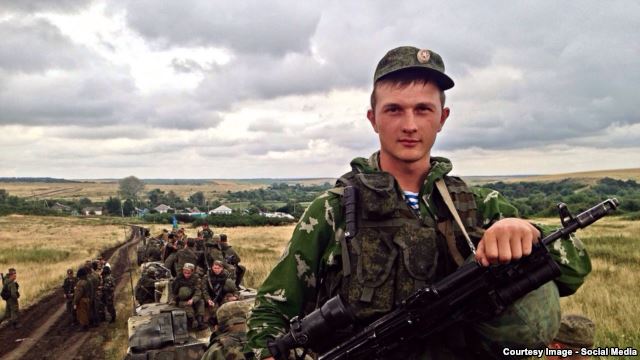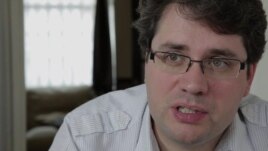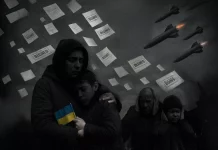
In June 2014, Russian soldier Stanislav Tarasov posted on a social-media site a photo of himself standing in front of a military convoy against a nondescript background of hills, fields, and scattered houses. It probably never occurred to him that such an innocuous image could become part of an increasingly detailed case being assembled in a bid to prove the Russian government has been lying when it denies militarily involvement in eastern Ukraine.
But that photo found its way into a dossier assembled by a volunteer group called Bellingcat for the Atlantic Council titled Hiding In Plain Sight: Putin’s War In Ukraine.
Bellingcat, which also uses digital forensics to uncover information about other conflicts and troublespots around the globe, has focused its efforts in Ukraine on the question of the presence of the Russian military and the issue of how Malaysian Airlines Flight 17 was shot down in July 2014. The group plans to issue a detailed report on MH17 later this month, but its earlier findings have asserted that the plane was downed by a BUK antiaircraft missile that was provided to the Ukrainian separatists by Russia.
The Russian government has consistently denied that it is involved militarily in Ukraine, saying the conflict there is a civil war.
“I can tell you outright and unequivocally that there are no Russian troops in Ukraine,” Russian President Vladimir Putin said on April 16. The Russian military has said MH17 was most likely shot down by the Ukrainian military.
“Tarasov was both a boring and an interesting case,” volunteer analyst Aric Toler of Bellingcat told RFE/RL’s Russian Service in an online interview. “It was easy to find his general location because he geotagged a [different] photo near an artillery firing range that had been shelling Ukraine…. From there, I was able to identify the exact spot of the photo using landmarks — in his case, houses, roads, and fields in the background. That was quite typical and I have done it hundreds of times.”
The “interesting” part of this investigation, Toler says, was that after he posted his findings, computer-savvy readers chimed in with their contributions and research that provided even stronger, more definitive evidence that the photo was taken near the Russian village of Pavlovka, from which Bellingcat believes Russian forces launched artillery strikes against Ukrainian territory.
The 10 volunteers from around the world at Bellingcat — and many others from organizations such as InformNapalm — are honing the techniques of digital forensic journalism — essentially, the art of sifting through all the dross on the Internet in search of nuggets of information.
“Digital forensic techniques involve verifying the locations of where videos and photographs were taken in a process known as ‘geolocating,'” the Atlantic Council’s report explains. “Geolocation techniques…allow an investigator to firmly establish the location of recorded images even without an embedded geotag (information in a computer file’s metadata that reveals its location).”
In the case of the war in eastern Ukraine, digital forensic investigators have used publicly available satellite imagery, Google maps images, and other open sources to place specific Russian soldiers from known Russian military units at precise locations in Ukraine and the border areas of Russia.
“I’m sure there are some Russian soldiers there now, but nothing like the August 2014 and February 2015 mobilizations,” Toler says.
Plowing through the nitty-gritty of Russian social media sites like VKontakte and Odnoklassniki might seem like tough work for a twentysomething from Kansas. But Toler says it isn’t too hard.
“I’ve had a lot of practice,” he says. “In graduate school, I did a large translation project with hundreds of NKVD (eds: Stalin-era Soviet secret police) documents. That was difficult as I had to work through unfamiliar jargon and faded handwriting. This is much easier because I can Google what I don’t understand or ask a Russian or Ukrainian.”
He stresses that the real innovation of digital forensics is its “open approach to information” that promotes “a more democratic analysis.”
“If people disagree with the analysis provided by a Bellingcat contributor, then that’s fine,” Toler argues. “He or she has access to the exact same information and, in most cases, tools as the contributor.”
Toler is realistic about the results that these new investigative techniques can achieve in the real world.
“I’m not so optimistic or Utopian about saving the world,” he says. “I know that even the most obvious, clear truth will be rejected by many because some minds can’t be changed. But I am a little bit Utopian in the idea of the potential of transparent, open-source information and its future uses in informing the public and key actors like journalists and politicians, as well as historians.”
“The best way to counter propaganda isn’t with reciprocal propaganda but with transparent sourcing of information that allows others to make their own critical judgments,” he adds.
ByDmitry Volchek, RFE/RL
RFE/RL correspondent Robert Coalson contributed to this report







